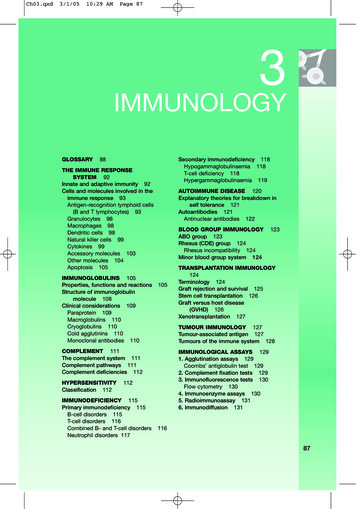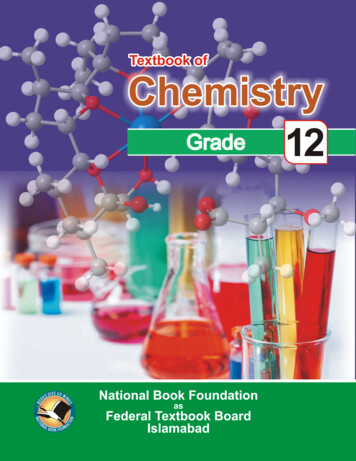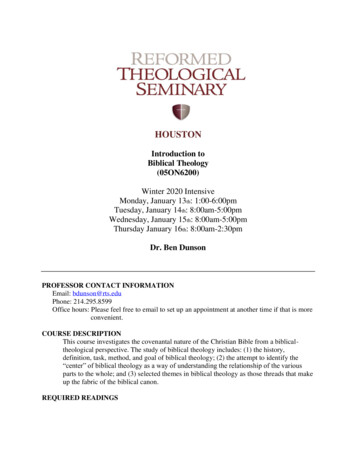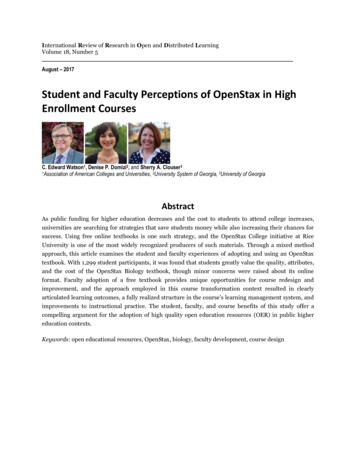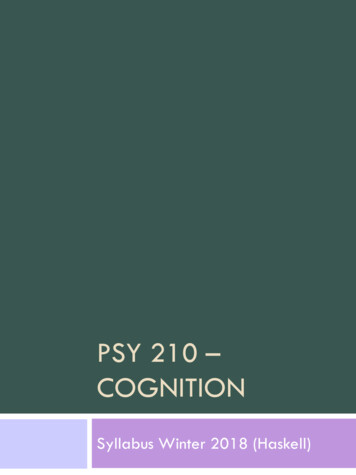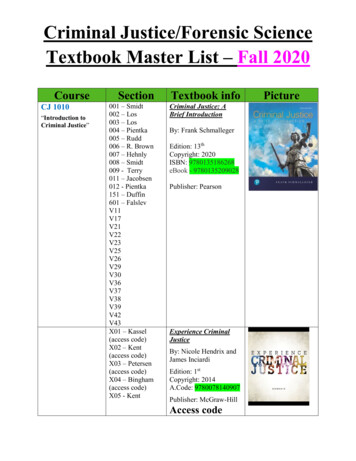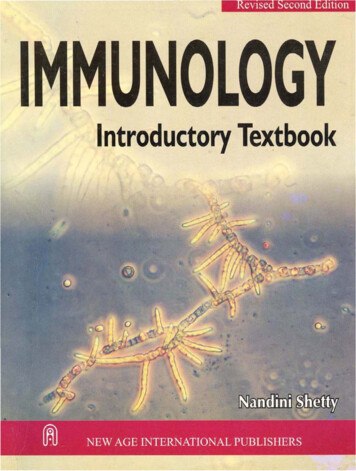
Transcription
t5!4 1S."*,.'iI.I'mI.]ilIntroductory Textbook@NEW AGE INTERNATIONAL PUBLlSIIERS
IMMUNOLOGY
THIS PAGE ISBLANK
Copyright 2005 New Age International (P) Ltd., PublishersPublished by New Age International (P) Ltd., PublishersAll rights reserved.No part of this ebook may be reproduced in any form, by photostat, microfilm,xerography, or any other means, or incorporated into any information retrievalsystem, electronic or mechanical, without the written permission of the publisher.All inquiries should be emailed to rights@newagepublishers.comISBN (10) : 81-224-2335-3ISBN (13) : 978-81-224-2335-8PUBLISHING FOR ONE WORLDNEW AGE INTERNATIONAL (P) LIMITED, PUBLISHERS4835/24, Ansari Road, Daryaganj, New Delhi - 110002Visit us at www.newagepublishers.com
for Dushyant & Meghna my greatest critics–my strongest supporters
THIS PAGE ISBLANK
PREFACE TO THE SECOND EDITIONAs textbooks and journals of immunology grow in size and number and the explosion ofinformation floods the libraries, students often find themselves overwhelmed by the volume ofreading required to understand basic concepts. Assimilating a fast changing, ever expandingsubject like immunology can be a daunting process. As a teacher of immunology and clinicalmicrobiology for undergraduate medical students, I have tried to present the basic tenets of thesubject of immunology in a simple and understandable manner, very much like the manylectures I have given to students over the years. I have tried to evolve a story so that studentsmay be inspired to read on and experience the wonder of scientific discovery. To this end I owemy own enjoyment of the subject to the many excellent articles in ‘Scientific American Medicine’,to the pictorial presentation of immunological concepts in Ivan Roitt’s excellent textbooks ofImmunology and to ‘Basic and Clinical Immunology’ of the Lange Medical Publication series. Igratefully acknowledge these sources for the many ideas and figures that I have adapted forthis book. The second edition has been carefully updated, with some chapters being rewrittenincorporating several new illustrations, in keeping with scientific advances. A new chapterdedicated to the immunology of HIV has been added in recognition of the devastating pandemicthat has re-defined global health. I hope the book will be of use to students of medicine,microbiology, nursing and for any one else in the life sciences who feels the need to explore thisfascinating area of science.LondonNandini Shetty
THIS PAGE ISBLANK
PREFACE TO THE FIRST EDITIONAs textbooks and journals of immunology grow in size and number and the explosion ofinformation floods the libraries, students often find themselves overwhelmed by the volume ofreading required to understand basic concepts. Assimilating a fast changing, ever expandingsubject like immunology can be a daunting process. As a teacher of immunology and clinicalmicrobiology for undergraduatemedical students, I have tried to present the basic tenets of thesubject of immunology in a simple and understandable manner, very much like the manylectures I have given to students over the years. I have tried to evolve a story so that studentsmay be inspired to read on and experience the wonder of scientific discovery. To this end lowemy own enjoyment of the subject to the many excellent articles in 'Scientific American Medicine',to the pictorial presentation of immunological concepts in Ivan Roitt's excellent textbooks ofImmunology and to 'Basic and Clinical Immunology' of the Lange Medica! Publication series. Igratefully acknowledge these sources for the many ideas and figures that I have adapted forthis book. I hope the book will be of use to students of medicine, microbiology, nursing and foranyone else in the life· sciences who feels the need to explore this fascinating area of science.LondonNandini Shetty
THIS PAGE ISBLANK
LIST OF ABBREVIATIONSChapter 1BCGC regionFabFcHLAMHCT cellV regionBacille Calmette GuerinConstant regionFraction antigen bindingFraction crystallizableHuman leukocyte antigenMajor histocompatibility complexThymus derived cell or thymocyteVariable regionChapter 2CRPIL-1IL-2IL-3IL-4IL-5IL-6IL-7NADPHC-reactive proteinInterleukins-1 to 7Nicotinamide adenosine dinucleotide phosphate hydrogenChapter 3CDGALTMALTMBPMPSNKPMNCluster of differentiationGut associated lymphoid tissueMucosal associated lymphoid tissueMajor basic proteinMononuclear phagocyte systemNatural killerPolymorphonuclear neutrophilChapter 4DNPDinitrophenyl
(xii)Chapter 5CDRCHCLH chainL chaninVHVLComplementarity determining regionsConstant heavyConstant lightHeavy chainLight chainVariable heavyVariable lightChapter 6D regionIVSJ regionDiversityIntervening sequencesJoining regionChapter 7PSLESRS-AProperdinSystemic lupus erythematosusSlow reacting substance-AChapter ageCarcinoembryonic antigenCounter immunoelectrophoresisEnzyme linked immunosorbent assayHepatitis B surface antigenHuman immunodeficiency virusImmunoelectrophoresisIndirect/Passive haemagglutinationRadio allergosorbent testRadio immunoassayRadio immunosorbent testReverse passive haemagglutinationSodium dodecyl sulphate-Polyacrylamide gel electrophoresisChapter 9HATHPRTPEGHypoxanthine aminopterin thymidineHypoxanthine phosphoribosyl transferasePolye thylene glycolChapter 10GBMHTCIr genesIs genesGlomerular basement membraneHomozygous typing cellsImmune response genesImmune suppressor genes
(xiii)MLRPLTMixed lymphocyte reactionPrimed lymphocyte typingChapter 11TCRT cell receptorChapter 12APCBCDFBCGFICAMIFNIP3LFATcThAntigen presenting cellB cell differentiation factorB cell growth factorIntercellular adhesion moleculeInterferonInositol triphosphateLymphocyte function associated antigenT cytotoxicT helperChapter 13ADCCBAFLAFLPSMAFMDPMIFMulti-CSFAntibody dependent cellular cytotoxicityB cell activating factorLymphokine activating factorLipopolysaccharideMacrophage activating factorMuramyl dipeptideMigration inhibitory factorMulti-Colony stimulating factorChapter 14CMIEBVECFESPFACSGM-CSFHTLV 1HTLV 2LIFLTOAFPHAPPDPWMTNFCell mediated immunityEpstein Barr virusEosinophil chemotactic factorEosinphil stimulatory promoterFluorescence activated cell sorterGranulocyte-monocyte colony stimulating factorHuman T cell leukemia virus 1Human T cell leukemia virus 2Lymphocyte inhibitory factorLymphotoxinOsteoclast activating factorPhyto haemagglutininPurified protein derivativePokeweed mitogenTumour necrosis factor
(xiv)Chapter 15ECF-ANCF-APKEosinophil chemotactic factor-anaphylaxisNeutrophil chemotactic factor-anaphylaxisPrausnitz küstnerChapter 16Ab 1, 2, 3BSAId 1, 2, 3LATSNZBNZWAntibody 1, 2, 3Bovine serum albuminIdiotype 1, 2, 3Long acting thyroid stimulatorNew Zealand blackNew Zealand whiteChapter 17LAKLymphokine activated killerChapter 18GVHSCIDGraft versus hostSevere combined immunodeficiencyChapter 19DNFBFeLVMCADinitroflurobenzeneFeline leukemia virusMethyl cholanthreneChapter 21HIGVZIGHuman immunoglobulinVaricella zoster immune globulinChapter 22ADAAIDSCVIDAdenosine deaminaseAcquired immunodeficiency sundromeCombined variable immunodeficiency
CONTENTSPreface to the Second Edition . viiPreface to the First Edition . ixList of Abbreviations . xi1.Milestones in Immunology . 12.Innate Immunity . 53.Immunobiology . 124.Antigens and Immunogenicity . 205.Immunoglobulins I: Structure and Function . 256.Immunoglobulins II: The Genetics of Antibody Diversity . 337.The Complement System . 398.Detection and Application of Antigen-Antibody Reactions . 509.Monoclonal Antibodies . 7010. The Major Histocompatibility Complex . 7511. Immune Response Mechanismis I: B and T Lymphocytes . 8712. Immune Response Mechanismis II: Antigen Presentation andProcessing; Mechanisms of Lymphocyte Activation . 9713. Cytokines . 10714. Cell-Mediated Immunity . 11715. Hypersensitivity . 12616. Immunologic Tolerance and Autoimmunity . 14317. Immunopotentiation and Immunosuppression . 14418Transplantation Immunology . 15819. Tumour Immunology . 16620. Immunity Against Infectious Diseases . 17421. Immunization . 18022. Immunodeficiency Diseases . 18623. Immunology of HIV Infection . 19724. Immunity and Malnutrition . 200Index . 203
THIS PAGE ISBLANK
CHAPTER – 1MILESTONES IN IMMUNOLOGYWith the evolution of the germ theory of disease, the study of the mechanisms ofimmunity and the possible conquest of infectious diseases began almostsimultaneously. Interest in immunology grew out of the everyday evidence that those individualswho survived: pocked and disfigured from the dread disease, small pox never did contract theinfection again. As early as 1773, Voltaire reported on an ancient Chinese custom where driedand powdered small pox scabs were inhaled, much like snuff, in at attempt at preventing thedisease. Although it would take several years before bacteria and viruses were fully characterized,theorists were already elucidating the mechanisms of host defence against infectious diseasesand their possible prevention.The phagocytic theory was the first to be developed in the 1880s a bold and imaginativeconcept — the fruit of Elie Metchnikoff’s deep knowledge of biology. Metchnikoff hypothesizedthat the basis of inflammation was the cellular reaction and that vascular and nervous reactionswere only of secondary importance. He postulated further that these migrating cells whichwere able to move in order to meet an enemy were the major guardians of health againstbacterial infections. It was around this time that Louis Pasteur reported on the treatment ofhis first two patients with rabies using early vaccines. In 1888 Metchnikoff left Russia to continuehis work on phagocytosis in Pasteur’s Institute in Paris. In 1908 he shared the Nobel Prizewith Paul Ehrlich for his early contributions to the understanding of inflammation.After Metchnikoff died in 1916 other workers who had long cherished the theory thatsoluble substances in blood were also bactericidal, reported their observations. Behring,Nuttall and Nissen contributed substantially to the concept of soluble or humoral factorsbut found that these factors were not always bactericidal. Finally in 1903, Almroth Wrightwith his disciple Stewart Douglas observed that a humoral component which they designatedopsonin, could render bacteria susceptible to phagocytosis. They thus forged a link betweenthe two major theories of immunity. Since the time humoral and cellular components wereshown to be interwoven in an intricate pattern, the complex chemicals associated with immunityhave been the continuing subject of years of research.Mere empirical methods of producing or increasing immunity were not sufficient, thewhole basis of immunity needed questioning. Behring found that certain diseases were theexpression of the action of toxins which could be neutralized by antitoxins. And it could notbe ignored that the blood of animals contained certain preformed bactericidal agents. Emilvon Behring and Kitasato in 1890 inoculated animals with toxins of diphtheria and tetanus,to produce neutralizing antitoxin serum. They introduced passive immunization into modernmedicine and for this, von Behring was awarded the French legion of honour and the NobelPrize in 1901. Behring maintained cordial ties with Pasteur - one of his great heroes and withMetchnikoff he established a continuing friendship that began in 1888. This friendship wasunique because the two men were at opposite poles in explaining basic aspects of immunity -yetenjoying the stimulus of intellectual debate.
2Immunology– Introductory TextbookThough eminently successful in passive immunization against diphtheria and tetanus,von Behring failed abysmally when he tried to extend these principles to passive immunizationagainst tuberculosis. At this time Robert Koch too had to taste failure in his attempts atproviding a successful vaccine against tuberculosis. The prevention of tuberculosis was not tobe found by the Germans. It was in France that Albert Calmette and Camille Guerindeveloped an effective vaccine for tuberculosis by the methods of attenuation so dear toPasteur and disdained by Koch.To establish a live but attenuated strain of Mycobacterium tuberculosis they had tocontinually transfer or sub culture the organism till virulence was lost. This odyssey took themthirteen years and 230 transfers later, on Jan. 5, 1921 it was completely avirulent even at highdoses for all animal species. The Bacille Calmette Guerin (BCG) was thus born - it did notinduce the formation of tubercles by intravenous, intraperitoneal or subcutaneous inoculationor even by ingestion, but formed an effective prophylactic against tuberculosis.Pfeiffer in 1894-95, discovered the phenomenon of in–vivo cytolysis of Vibrio choleraewhen the organism and immune serum interacted intraperitoneally in the guinea pig. Fromthese early experiments the nature and function of complement mediated cytolysis wereelucidated by Pfeiffer and later by Buchner and Bordet. Jules Bordet was awarded the NobelPrize in 1920 for his pioneering work on complement, for his discovery of the whooping coughagent and for his enunciation of the diverse aspects of antigen – antibody reactions and theblood coagulation system. Around this time Gruber and Durham described the diagnosticvalue of the agglutination reaction, when agar cultures were mixed with their correspondingimmune sera. The same year Ferdinand Widal the Algerian born son of a French armysurgeon described the agglutination reaction for typhoid fever—a test which is still widely usedand bears his name.In 1667, Jean Baptiste Denis, physician to Louis the XIV, performed what is consideredto be the first transfusion of blood in man. The experiment was not well received by hisfellow-physicians who were more accustomed to blood-letting than reversing the flow. Till theearly 1900s the practice of transfusion of blood from man to man remained a risky, unpredictablebusiness, when at the turn of the century, Carl Landsteiner discovered the blood groups.Landsteiner received the Nobel Prize in 1930 for elucidating the blood groups and for his workon the Rh factor.As serotherapy developed, it soon became evident that antigen- antibody reactions invivo could have some harmful effects and even produce death. Anaphylaxis, the mostdramatic manifestation of hypersensitivity was first described by P.Portier and CharlesRichet in 1902. In 1913 Charles Richet received the Nobel Prize in recognition of his workon anaphylaxis.Two of the most vital immunological hypotheses made in the 1800s went undetected forseveral decades. They were rediscovered only in the 1940s and form a basis of the study ofimmunology today. Elie Metchnikoff suggested that phagocytes were the prime detectors offoreign material— we trace the origins of cellular immunity to this hypothesis. Paul Ehrlichproposed the pre–existence of receptors (which he called toxophores) on the living cell, thatreacted with toxins. Excess receptors were liberated into the circulation as antibodies–themolecular basis of humoral immunity, as we know it today, is remarkably close to this novelbut original concept. Thus, the foundations of modern immunology, as we recognize it today,were laid by several European scientists over the last hundred or more years.The twentieth century saw phenomenal progress in the understanding of immunologicalconcepts. How antigens direct the various immunological processes was the chief point ofcontention among early theorists who had to choose between the instructive and the selective
Milestones in Immunology3theories. In the past 30 years the biological basis of the immune response was, in part, clarifiedwhen the theory of clonal selection of antibody formation found acceptance. This theoryproposed, in essence, by Paul Ehrlich almost a 100 years ago fell out of favour with theintroduction of the template theory. The first comprehensive attack against the template theorywas launched in 1955 by Niels Kaj Jerne who recalled certain criticisms made by MacfarlaneBurnet against the template theory. It, however, remained for Burnet to draw together thenew conceptualization and in 1957, he asserted that “each cell and its clones can produce justone kind of receptor” to explain the specificity of the immune response and the exponential risein antibody production following contact with antigen. The secondary response is more powerfulbecause antigenic memory leads to rapid clonal expansion during subsequent contact with thesame antigen. We know today that during this second exposure the binding ability of antibodyimproves and we also know this to be the result of affinity maturation and somatichypermutation. The clonal selection theory also explained tolerance as the deletion orsuppression of an entire clone of cells which could occur before or soon after birth; or evenmuch later in some instances. Macfarlane Burnet was awarded the Nobel Prize in 1960 whichhe shared with Peter Medawar. In 1984 Niels Jerne was also awarded the Nobel Prize for histheoretical contributions to immunology, the most fundamental of which was his role indeveloping he concept of clonality and for his description of the idiotype network in the regulationof immune responses.The elucidation of antibody structure is credited to Rodney R. Porter and GeraldM. Edelman who shared the Nobel Prize for their discovery in 1972. In 1959 Edelman showedthat the immunoglobulin molecule had 4 polypeptide chains: 2 of each kind and that each couldbe separated by chemical means. He called them light and heavy chains because of their size.At the same time Porter showed that the molecule could be cut into 3 different pieces ( Fab x2; Fc x 1) by enzymes that cleave polypeptides. In 1970 Edelman showed that chemical differencesresponsible for the specificity of antigen binding were embodied in the amino acid sequences oftheir variable regions at the upper, outer arms of the antibody molecule. All subsequent workhas confirmed his conclusions with some elaborations. In 1970 T.T. Wu and E.A Kabatdemonstrated the presence of hyper variable regions.Dreyer and Bennet in 1965, suggested that the germ line contains many variable (V)region genes and one constant (C) region gene, which combine to yield an immunoglobulinmolecule. As a cell matures, it selects one V gene out of many and combines it with the one Cregion gene. The theory was attractive; yet it required that the cell have some means ofrearranging genes in somatic cells. Evidence that immunoglobulin genes do undergo somaticrecombination, but in more complicated ways than Dreyer and Bennet suggested, was foundin 1970 by Hozumi and Tonegawa then at Basel, Switzerland. They demonstrated that V andC genes were far apart in embryonic cells but much closer to each other in plasma cells. Theyalso delineated the mechanism of shuffling of the many gene segments. Tonegawa was awardedthe Nobel Prize in 1987 for elucidating the mechanism by which the immune system generatesan almost limitless variety of antibodies. Somatic hypermutation, as another major source ofthe tremendous diversity of antibody specificity generated, was demonstrated by Weigert andCohn in 1970.The production of monoclonal antibodies by somatic cell hybridization of antibodyforming cells and continuously replicating cell lines was called the technique of hybridomaformation. This technique described by Georges Kohler and Cesar Milstein in 1975, hasenabled immunologists to prepare virtually unlimited quantities of antibodies that arechemically, physically and immunologically completely homogenous. For this invaluablecontribution to immunology they were awarded the Nobel Prize in 1984.
4Immunology– Introductory TextbookImmunobiology of transplantation and tolerance was an active field of research in the1940s and 50s. In 1953, Medawar, Brent and Billingham performed a series of dazzlingexperiments to explain the mechanisms that enable the host to recognize and destroy foreigncells. Medawar showed conclusively that such a mechanism was immunological. He suggestedthat specific individuality markers were associated with every cell of an organism and that ananimal can be immunized against foreign grafts by first injecting it with cells derived fromimmunocompetent tissues of the donor. Earlier Ray Owen had shown, in his classic experimentwith dizygotic twin calves, that dissimilar blood group antigens of one calf were tolerated by theother twin calf. Drawing from this experiment Medawar demonstrated that an inbred strain ofmice – strain A could be made to tolerate skin grafts from another inbred strain – strain B byinjecting the strain A animal soon after birth with strain B spleen cells. With this experimenthe proved that resistance (or the lack of it) to foreign tissue is an immunological phenomenon.Peter Medawar was awarded the Nobel Prize (with Burnet) in 1960.Existence of markers of biological individuality – what we now know as thehistocompatibility antigens was first suggested by Gorer in 1937, who demonstrated thatloci determining blood group antigens and those controlling tumour rejection in mice weredistinct. With Snell in 1948 he showed that there were multiple alleles in the mouse H-2 locusand subsequently that this locus was genetically complex. The H-2 locus was shown to controlthe phenotype expression of certain cell surface markers in mice. In 1950 Dausset identifiedthe HLA ( Human Leukocyte Antigen) locus or MHC (major histocompatibility complex) as it issometimes called. Benacerraf showed that genes of the HLA determining loci may controlimmune responses. Snell, Dausset and Benacerraf were awarded the Nobel Prize in 1980.Elucidation of the structures of some HLA molecules by Bjorkman and Wiley in 1987, usingX-ray crystallography, revealed that the molecules of the major histocompatibility complex(MHC) bind to antigenic peptides and present these peptides to the T cell receptor.First glimpsed in experiments by Allison, and Kappler & Reinherz, the T cell receptorwas studied and characterized by Tak W.Mak and Mark M. Davis in 1984. These workerscloned and sequenced a gene expressed and rearranged in T cells but not in B cells. Theiranalysis showed that many of the T cell receptor sequences were homologous to those ofimmunoglobulin genes. Peter Doherty with Rolf M. Zinkernagel, found that T cells frommice infected with a meningitis virus destroyed virus-infected cells only from the same strainof mice, and they showed that T cells must recognize two signals on an infected cell—one fromthe virus and one from the cell’s own antigens—to destroy it. For this new understanding ofcellular immune mechanisms they shared the Nobel Prize in 1996.Immunology continues to fascinate and frustrate researchers the world over. A betterunderstanding of tumour immunology, autoimmunity and responses to immunization coulddevelop into strategies for protection against many crippling diseases. Eventually, what hasevolved as a precise and powerful tool created by nature to ensure the continued survival of thespecies could perhaps be manipulated to yield a better quality of life.Bibliography1. Lechevalier HA and Solotorovsky M. Three centuries of Microbiology DoverPublications Inc; New York, 1974.2. Parish, H.J. A. History of Immunization, E. and S. Livingstone, Ltd, Edinburgh,1965.
CHAPTER – 2INNATE IMMUNITYTaliaferro said, “The host is an island invaded by strangers with different needs, differentfood requirements, different localities in which to raise their progeny”. There are aformidable range of infectious agents that can use the human body as a sanctuary to raise theiroffspring. The immune system faces the task of providing a defence mechanism to establish astate that is known as immunity to infection.The contemporary definition of immunity is therefore: “All those physiologicalmechanisms that endow the animal with the capacity to recognize materials as foreign to itselfand to neutralize, eliminate or metabolize them with or without injury to its own tissues”.Immunological responses serve three broad functions: Defence against micro organisms Homeostasis; removal of damaged or effete cells Surveillance; recognition and destruction of mutant cells.These responses have been widely classified as non–specific and specific. Among thenon-specific defence mechanisms there are those that form a set of ill understood and perhapsgrossly under-emphasized constitutional factors that make one species innately susceptibleand another resistant to certain infections.These constitutional factors can best be listed as–(a) Genetic: between species, for example: Mycobacterium leprae seems to infect humans and armadillos only. Bacillus anthracis is an infection of humans though not of chickens. Gonorrhoea is a disease of man and chimpanzees and not of any other species. Somespecies seem to be able to harbour organisms within their body tissues while thesame organism may cause another species to succumb to such an infection. Withinman, there are certain well known racial differences in disease susceptibility: dark skinned individuals have an increased susceptibility to coccidioidomycosis. certain dark skinned people lack the red cell Duffy coat and are not susceptibleto vivax malaria.Genetic control of disease has been shown to be strongly associated with the majorhistocompatibility complex.(b) Age: The very young are more susceptible to many infections, in particular, Escherichiacoli meningitis; this may be because bactericidal IgM does not cross the placenta.At the other end of the spectrum rickettsial infections and certain viral infections ofchildren are more severe with age.
6Immunology– Introductory Textbook(c) Metabolic: Hypoadrenal and hypothyroid states decrease resistance to infection. Indiseases such as diabetes mellitus where altered metabolism causes increase in blood glucose,decrease in pH and a reduced influx of phagocytes - infection can be a severe complication.Steroid hormones are known to affect many modalities of the immune response.(d) There is a growing body of evidence that supports the hypothesis that immune processescan be influenced by neuroendocrine factors. Immunologic cells have receptors for a wholerange of hormones. Corticosteroids, androgens, oestrogens and progesterone depress immuneresponses, whereas growth hormone, insulin and thyroxine do the opposite. Immunologic organsare innervated by autonomic and primary sensorial neurons; hormone secretion is balanced byneural control. It therefore seems reasonable to say that immune responses are finely tunedby neuro endocrine circuits. At a more physiologic level, stress and circadian rhythms modifythe functioning of the immune system.(e) Environment: Poor living conditions, overcrowding and undernutrition also increasesusceptibility to infection.Figure 2.1. Natural barriers to infectious agents.Natural barriers to infectious agents are simple yet effective means of innate defence(Figure 2.1). A major form of defence in this context is the intact skin which is impermeableto most infectious agents. Sweat and sebaceous glands are potential points of entry for theinfectious agent. However, most bacteria fail to enter due to the low pH and direct inhibitoryeffects of lysozymes, lactic acid and other fatty acids of sweat and sebaceous secretions. Anexception is Staphylococcus aureus which commonly infects the hair follicle and glands.Mucus secretions of the tracts that connect internal organs to external surfaces forman important form of defence. They entrap and immobilize bacteria and hence, prevent adherenceand colonization of epithelial surface
microbiology for undergraduate medical students, I have tried to present the basic tenets of the subject of immunology in a simple and understandable manner, very much like the many lectures I have given to students over the years. I have tried to evolve a story so that students . 6 Immunology
